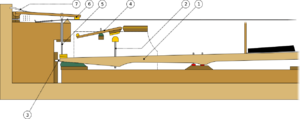Johannes Zumpe facts for kids
Johannes (Johann Christoph) Zumpe (pronounced zumpy; born 14 June 1726 in Fürth, a city in modern Germany – died 5 December 1790 in London, UK) was a very important maker of early English square pianos. These pianos were rectangular and had a range of about five octaves, which means they could play many notes. They sounded a bit like soft harpsichords. Zumpe is famous for creating the English square piano style.
Zumpe's Life Story
Johannes Zumpe was born in June 1726 in Germany. He learned how to build musical instruments from Gottfried Silbermann, a famous instrument maker. Zumpe was one of a group of German instrument makers, sometimes called the "twelve Apostles," who moved to London during the Seven Years' War.
He worked for a short time with another maker named Burkat Shudi. Then, in 1761, Zumpe opened his own shop. It was called "at the sign of the Golden Guittar" and was located in Princes Street, Hanover Square.
From 1769 to 1778, Zumpe worked with Gabriel Buntebart. Later, in 1778, Meincke Meyer joined Zumpe's business. In 1783, Frederick Schoene took over the company. He proudly advertised his piano-making firm as the "Successors to Johannes Zumpe."
Zumpe's Pianos
Pianos made in Zumpe's style were built from around 1760 to 1800. In Zumpe's time, these square pianos were like the upright pianos we see today. They were smaller and cost less than the big, wing-shaped pianos.
Because they were more affordable, Zumpe's pianos helped many people start playing the piano. This included many amateur musicians, who played for fun. By the time the last Zumpe pianos were made, the piano had become much more popular than the harpsichord.
A famous musician named Johann Christian Bach even performed on a Zumpe piano. He might have also helped sell Zumpe's instruments. While Zumpe is best known for his square pianos, he also made other instruments. These included full-sized pianos, harpsichords, an English guitar in 1762, and a mandora in 1764.
How the Piano Action Works
The "action" of a piano is the set of parts that makes the hammer hit the string when you press a key. The action in Zumpe's small square pianos is called the "English single" action. It is very simple, much simpler than the first piano action invented by Bartolomeo Cristofori.
Here is how it works: A small part called a "sticker" simply pushes up a hammer. At the same time, a rod lifts a damper lever. The damper is what stops the sound of the string. You can see how these parts fit together in the picture below.
Here are the main parts of the action:
- key; this is the part you press with your finger.
- jack; this is a wire with a leather top, sometimes called the "old man's head."
- whalebone rear guide; this part sticks out from the key and moves in a groove to keep the key steady.
- hammer; this part hits the string to make a sound.
- whalebone jack, called the mopstick.
- damper; when this part is down, it stops the string from vibrating and making sound.
- whalebone damper spring.


